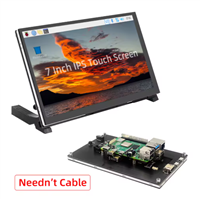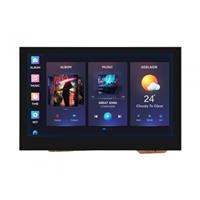Edoardo kinmami
JAPAN • + Follow
Edit Project
Description
Commodore 16 (C16) Plus 4 RF modulator replacement
Commodore 16 (C16) & Plus/4 RF modulator replacement
Inspired by projects from c0pperdragon, mbarszcz-pcb, tebl and VGP. It fits the commodore 16 & Plus/4 and replaces the RF modulator with an optional S-VIDEO port.
Based on THS7316, the PCB provides a crisp image in Y/C and COMPOSITE yet does not eliminate jail bars.
The original DIN port remains valid.
No effect on audio performance.
BOM list provided.
Feb 02,2022
2,745 views
end-flag
Commodore 16 (C16) Plus 4 RF modulator replacement
Inspired by projects from c0pperdragon, mbarszcz-pcb, tebl and VGP. It fits the commodore 16, Plus 4 and replaces the RF modulator.
2745
11
30
Published: Feb 02,2022
BOM(Bill of materials)
Centroid file
Purchase
Donation Received ($)
PCBWay Donate 10% cost To Author
File Last Updated: 2023/10/13 (GMT+8)
File update record
2023-10-1322:29:48
Centroid file is updated.
Only PCB
PCB+Assembly
*PCBWay community is a sharing platform. We are not responsible for any design issues and parameter issues (board thickness, surface finish, etc.) you choose.
Copy this HTML into your page to embed a link to order this shared project
Copy
Under the
Attribution-NonCommercial-ShareAlike (CC BY-NC-SA)
License.

Raspberry Pi 5 7 Inch Touch Screen IPS 1024x600 HD LCD HDMI-compatible Display for RPI 4B 3B+ OPI 5 AIDA64 PC Secondary Screen(Without Speaker)
BUY NOW
ESP32-S3 4.3inch Capacitive Touch Display Development Board, 800×480, 5-point Touch, 32-bit LX7 Dual-core Processor
BUY NOW
Raspberry Pi 5 7 Inch Touch Screen IPS 1024x600 HD LCD HDMI-compatible Display for RPI 4B 3B+ OPI 5 AIDA64 PC Secondary Screen(Without Speaker)
BUY NOW- Comments(30)
- Likes(11)
-
 Juan VM
Nov 25,2024
Juan VM
Nov 25,2024
-
 goatninja66
Oct 03,2024
goatninja66
Oct 03,2024
-
 Mr. Marsupial
May 10,2024
Mr. Marsupial
May 10,2024
-
 Francisco Meza
Feb 04,2024
Francisco Meza
Feb 04,2024
-
 Holger OnkelHolgi
Jan 26,2024
Holger OnkelHolgi
Jan 26,2024
-
 Zoltan Markus
Aug 05,2023
Zoltan Markus
Aug 05,2023
-
 Martin Maciaszek
Jul 13,2023
Martin Maciaszek
Jul 13,2023
-
 Adam Wilson
Aug 31,2022
Adam Wilson
Aug 31,2022
-
 Peter Dimitriovski
May 16,2022
Peter Dimitriovski
May 16,2022
-
 Mr Eddie Bannister
Feb 08,2022
Mr Eddie Bannister
Feb 08,2022
-
 (DIY) C64iSTANBUL
Feb 07,2022
(DIY) C64iSTANBUL
Feb 07,2022
View More
VOTING
0 votes
- 0 USER VOTES
0.00
- YOUR VOTE 0.00 0.00
- 1
- 2
- 3
- 4
- 5
- 6
- 7
- 8
- 9
- 10
Design
1/4
- 1
- 2
- 3
- 4
- 5
- 6
- 7
- 8
- 9
- 10
Usability
2/4
- 1
- 2
- 3
- 4
- 5
- 6
- 7
- 8
- 9
- 10
Creativity
3/4
- 1
- 2
- 3
- 4
- 5
- 6
- 7
- 8
- 9
- 10
Content
4/4
 More by Edoardo kinmami
More by Edoardo kinmami
-
 Commodore Amiga 500 Internal Dual Floppy Disk Drive Interface
In essence, this plug-in adapter for the Amiga 500 facilitates the simultaneous use of two types of ...
Commodore Amiga 500 Internal Dual Floppy Disk Drive Interface
In essence, this plug-in adapter for the Amiga 500 facilitates the simultaneous use of two types of ...
-
 74FCT646 74F646S 24 SOIC DIL AMIGA 3000 COMMODORE SOCKET ADAPTER SMT THT
An adapter to mount SMT 74FCT646 onto 24-DIL socket
74FCT646 74F646S 24 SOIC DIL AMIGA 3000 COMMODORE SOCKET ADAPTER SMT THT
An adapter to mount SMT 74FCT646 onto 24-DIL socket
-
 ATARI ST / STE RGB to VGA video Adapter with AV RCA JACK V2
Smart Solution for a Multisync Video Switch for Atari ST/STEAtari DIN13 to VGA3.5mm A/V jack connect...
ATARI ST / STE RGB to VGA video Adapter with AV RCA JACK V2
Smart Solution for a Multisync Video Switch for Atari ST/STEAtari DIN13 to VGA3.5mm A/V jack connect...
-
 Commodore Plus/4 64 128 VIC20 Stock Power Supply High Efficiency Low Noise 5V 9VAC Replacement V2
It replaces the internal board with a high-efficiency, high-current capability, low noise, fully pro...
Commodore Plus/4 64 128 VIC20 Stock Power Supply High Efficiency Low Noise 5V 9VAC Replacement V2
It replaces the internal board with a high-efficiency, high-current capability, low noise, fully pro...
-
 PCE_Expansion_Adapter_PCB
License: CERN-OHL-S-2.0Original author and credits: Jaakko Oranenhttps://codeberg.org/CBMretro/PC_En...
PCE_Expansion_Adapter_PCB
License: CERN-OHL-S-2.0Original author and credits: Jaakko Oranenhttps://codeberg.org/CBMretro/PC_En...
-
 PCE_DIN_Adapter_PCB
License: CERN-OHL-S-2.0Original author and credits: Jaakko Oranenhttps://codeberg.org/CBMretro/PC_En...
PCE_DIN_Adapter_PCB
License: CERN-OHL-S-2.0Original author and credits: Jaakko Oranenhttps://codeberg.org/CBMretro/PC_En...
-
 V2 Commodore AMIGA USB-C Power Sink Delivery High Efficiency Supply Triple Output 5V ±12V OLED display ATARI compatible shark 100W
Version 2Compact design for high efficiency (>92%) USB-C Power Supply for Amiga 500, 600, 1200.Tw...
V2 Commodore AMIGA USB-C Power Sink Delivery High Efficiency Supply Triple Output 5V ±12V OLED display ATARI compatible shark 100W
Version 2Compact design for high efficiency (>92%) USB-C Power Supply for Amiga 500, 600, 1200.Tw...
-
 Commodore AMIGA PSU USB-C Power Sink Delivery Supply High Efficiency Triple Output 5V ±12V OLED ATARI ST shark
NEW VERSION https://www.pcbway.com/project/shareproject/V2_Commodore_AMIGA_USB_C_Power_Sink_Delivery...
Commodore AMIGA PSU USB-C Power Sink Delivery Supply High Efficiency Triple Output 5V ±12V OLED ATARI ST shark
NEW VERSION https://www.pcbway.com/project/shareproject/V2_Commodore_AMIGA_USB_C_Power_Sink_Delivery...
-
 Commodore AMIGA LED 500 600 1200 2000 status board multi system for debugging and troubleshooting hardware
A LED status PCB to connect A500, A600, A1200, A2000 motherboards for troubleshooting purposes witho...
Commodore AMIGA LED 500 600 1200 2000 status board multi system for debugging and troubleshooting hardware
A LED status PCB to connect A500, A600, A1200, A2000 motherboards for troubleshooting purposes witho...
-
 Commodore MAX Machine RF modulator replacement S-VIDEO bypass
Inspired by projects from c0pperdragon, mbarszcz-pcb, tebl and VGP.It fits the commodore MAX MACHINE...
Commodore MAX Machine RF modulator replacement S-VIDEO bypass
Inspired by projects from c0pperdragon, mbarszcz-pcb, tebl and VGP.It fits the commodore MAX MACHINE...
-
 Enhanced Flash Floppy Drive Plus (internal) with push-buttons gotek
Enhanced Flash Floppy Drive Plus Improved Gotek for Commodore Amiga (internal and external), Atari, ...
Enhanced Flash Floppy Drive Plus (internal) with push-buttons gotek
Enhanced Flash Floppy Drive Plus Improved Gotek for Commodore Amiga (internal and external), Atari, ...
-
 Commodore Amiga DB23 RGB VGA External Video Buffer (V6) Compatible with GBS-8200 8220 OSSC No Jail bars
External RGB video adapter from DB-23 female (input) to DE-15F (output, VGA) for Amiga computers.Com...
Commodore Amiga DB23 RGB VGA External Video Buffer (V6) Compatible with GBS-8200 8220 OSSC No Jail bars
External RGB video adapter from DB-23 female (input) to DE-15F (output, VGA) for Amiga computers.Com...
-
 Commodore AMIGA 500 600 2000 Kickstart 29F800 FLASH DIL TSOP
It uses a 29F800 FLASH (50~70ns). You need to select the upper and lower banks using a shunt.BOM lis...
Commodore AMIGA 500 600 2000 Kickstart 29F800 FLASH DIL TSOP
It uses a 29F800 FLASH (50~70ns). You need to select the upper and lower banks using a shunt.BOM lis...
-
 TL866 Adapter Commodore AMIGA 500 600 2000 1200 3000 4000 Kickstart 29F800 FLASH TSOP48
Adapter for the TL866 Universal Programmer.To use with https://www.pcbway.com/project/shareproject/C...
TL866 Adapter Commodore AMIGA 500 600 2000 1200 3000 4000 Kickstart 29F800 FLASH TSOP48
Adapter for the TL866 Universal Programmer.To use with https://www.pcbway.com/project/shareproject/C...
-
 Commodore AMIGA 1200 3000 4000 Dual Kickstart 29F800 FLASH DIL TSOP
It uses two 29F800 FLASH (50~70ns). You need to select the upper and lower banks using a shunt.BOM l...
Commodore AMIGA 1200 3000 4000 Dual Kickstart 29F800 FLASH DIL TSOP
It uses two 29F800 FLASH (50~70ns). You need to select the upper and lower banks using a shunt.BOM l...
-
 Commodore AMIGA 1200 3000 4000 Dual Kickstart 27C800 EPROM DIL
It uses two 27C800 EPROMs (100~120ns). You need to select the upper and lower banks using a shunt.BO...
Commodore AMIGA 1200 3000 4000 Dual Kickstart 27C800 EPROM DIL
It uses two 27C800 EPROMs (100~120ns). You need to select the upper and lower banks using a shunt.BO...
-
 Commodore AMIGA 1200 3000 4000 Dual Kickstart 27C400 EPROM DIL
It uses two 27C400 EPROMs (100~120ns). You need to select the upper and lower banks using a shunt.BO...
Commodore AMIGA 1200 3000 4000 Dual Kickstart 27C400 EPROM DIL
It uses two 27C400 EPROMs (100~120ns). You need to select the upper and lower banks using a shunt.BO...
-
 COMMODORE AMIGA PC DOS STEREO AUDIO SAMPLER DIGITIZER PARALLEL PORT MASTER
Amiga Stereo Digitizer for Importing Audio Samples - Stereo Sound!This stereo digitizer/sampler was ...
COMMODORE AMIGA PC DOS STEREO AUDIO SAMPLER DIGITIZER PARALLEL PORT MASTER
Amiga Stereo Digitizer for Importing Audio Samples - Stereo Sound!This stereo digitizer/sampler was ...
-
 Commodore Amiga 500 Internal Dual Floppy Disk Drive Interface
In essence, this plug-in adapter for the Amiga 500 facilitates the simultaneous use of two types of ...
Commodore Amiga 500 Internal Dual Floppy Disk Drive Interface
In essence, this plug-in adapter for the Amiga 500 facilitates the simultaneous use of two types of ...
-
 74FCT646 74F646S 24 SOIC DIL AMIGA 3000 COMMODORE SOCKET ADAPTER SMT THT
An adapter to mount SMT 74FCT646 onto 24-DIL socket
74FCT646 74F646S 24 SOIC DIL AMIGA 3000 COMMODORE SOCKET ADAPTER SMT THT
An adapter to mount SMT 74FCT646 onto 24-DIL socket
-
 ATARI ST / STE RGB to VGA video Adapter with AV RCA JACK V2
Smart Solution for a Multisync Video Switch for Atari ST/STEAtari DIN13 to VGA3.5mm A/V jack connect...
ATARI ST / STE RGB to VGA video Adapter with AV RCA JACK V2
Smart Solution for a Multisync Video Switch for Atari ST/STEAtari DIN13 to VGA3.5mm A/V jack connect...
-
 Commodore Plus/4 64 128 VIC20 Stock Power Supply High Efficiency Low Noise 5V 9VAC Replacement V2
It replaces the internal board with a high-efficiency, high-current capability, low noise, fully pro...
Commodore Plus/4 64 128 VIC20 Stock Power Supply High Efficiency Low Noise 5V 9VAC Replacement V2
It replaces the internal board with a high-efficiency, high-current capability, low noise, fully pro...
-
 PCE_Expansion_Adapter_PCB
License: CERN-OHL-S-2.0Original author and credits: Jaakko Oranenhttps://codeberg.org/CBMretro/PC_En...
PCE_Expansion_Adapter_PCB
License: CERN-OHL-S-2.0Original author and credits: Jaakko Oranenhttps://codeberg.org/CBMretro/PC_En...
-
 PCE_DIN_Adapter_PCB
License: CERN-OHL-S-2.0Original author and credits: Jaakko Oranenhttps://codeberg.org/CBMretro/PC_En...
PCE_DIN_Adapter_PCB
License: CERN-OHL-S-2.0Original author and credits: Jaakko Oranenhttps://codeberg.org/CBMretro/PC_En...
-
 V2 Commodore AMIGA USB-C Power Sink Delivery High Efficiency Supply Triple Output 5V ±12V OLED display ATARI compatible shark 100W
Version 2Compact design for high efficiency (>92%) USB-C Power Supply for Amiga 500, 600, 1200.Tw...
V2 Commodore AMIGA USB-C Power Sink Delivery High Efficiency Supply Triple Output 5V ±12V OLED display ATARI compatible shark 100W
Version 2Compact design for high efficiency (>92%) USB-C Power Supply for Amiga 500, 600, 1200.Tw...
-
 Commodore AMIGA PSU USB-C Power Sink Delivery Supply High Efficiency Triple Output 5V ±12V OLED ATARI ST shark
NEW VERSION https://www.pcbway.com/project/shareproject/V2_Commodore_AMIGA_USB_C_Power_Sink_Delivery...
Commodore AMIGA PSU USB-C Power Sink Delivery Supply High Efficiency Triple Output 5V ±12V OLED ATARI ST shark
NEW VERSION https://www.pcbway.com/project/shareproject/V2_Commodore_AMIGA_USB_C_Power_Sink_Delivery...
-
 Commodore AMIGA LED 500 600 1200 2000 status board multi system for debugging and troubleshooting hardware
A LED status PCB to connect A500, A600, A1200, A2000 motherboards for troubleshooting purposes witho...
Commodore AMIGA LED 500 600 1200 2000 status board multi system for debugging and troubleshooting hardware
A LED status PCB to connect A500, A600, A1200, A2000 motherboards for troubleshooting purposes witho...
-
 Commodore MAX Machine RF modulator replacement S-VIDEO bypass
Inspired by projects from c0pperdragon, mbarszcz-pcb, tebl and VGP.It fits the commodore MAX MACHINE...
Commodore MAX Machine RF modulator replacement S-VIDEO bypass
Inspired by projects from c0pperdragon, mbarszcz-pcb, tebl and VGP.It fits the commodore MAX MACHINE...
-
 Enhanced Flash Floppy Drive Plus (internal) with push-buttons gotek
Enhanced Flash Floppy Drive Plus Improved Gotek for Commodore Amiga (internal and external), Atari, ...
Enhanced Flash Floppy Drive Plus (internal) with push-buttons gotek
Enhanced Flash Floppy Drive Plus Improved Gotek for Commodore Amiga (internal and external), Atari, ...
-
 Commodore Amiga DB23 RGB VGA External Video Buffer (V6) Compatible with GBS-8200 8220 OSSC No Jail bars
External RGB video adapter from DB-23 female (input) to DE-15F (output, VGA) for Amiga computers.Com...
Commodore Amiga DB23 RGB VGA External Video Buffer (V6) Compatible with GBS-8200 8220 OSSC No Jail bars
External RGB video adapter from DB-23 female (input) to DE-15F (output, VGA) for Amiga computers.Com...
You may also like
-
-
-
Modifying a Hotplate to a Reflow Solder Station
858 1 5 -
MPL3115A2 Barometric Pressure, Altitude, and Temperature Sensor
444 0 1 -
-
Nintendo 64DD Replacement Shell
376 0 2 -
V2 Commodore AMIGA USB-C Power Sink Delivery High Efficiency Supply Triple Output 5V ±12V OLED display ATARI compatible shark 100W
1093 4 2 -
How to measure weight with Load Cell and HX711
692 0 3












































on Mine. Video Amp = 3.288v, Pin 8 = .914v, Pin 7 = 2.106v, Pin 6 = .820v. I get the same reading from the board no matter if the video cable is plugged in or not. It seems something is causing Pin 7 to supply the wrong voltage. Could PCBWay have used the wrong value resister somewhere, if so, which would be the likely one?
I just checked the resistors on the board, 4 of them are out of spec on the installed board. I had 10 of these built. I will check the others tomorrow.
Nominal resistors value is written on the top silk layer of the PCB.
I have now solder all 3 point to ground, but makes no difference. The colour bleed occurs on both the CRT and LCD screens, also I tried two different cables and made no difference at all.
The components appear to be correct in value and position. C16 and Plus/4, C116 are electrically equivalent, then I suggest you check the voltage levels with a scope and multimeter. Verify if the 3.3V is steady at the video amp input and if the composite video level is between 1.0V to 1.1V (with the monitor connected). The blurry, yellow ghosting effect is likely caused by incorrect termination or improper voltage levels at the composite video.
Ok so I measured the voltage between Pin 7 on the Board and Ground on the board and I get 2v. I then measure the voltage directly on the RCA cable and I get 1.8v. I measure the RCA cable voltage with my unmodified c116 and Plus/4 and both read 1.5v. So your board is outputting an additional 300mv which I assume is significant? I don't know which chip is the video amp and which pins to measure for the 3.3v
I have posted several photos with actual voltage reading, FYR. Again be sure your cable has not an in-series resistor and/or your monitor is correctly 75ohm-terminating the COMPOSITE VIDEO to ground. The circuit is designed to work with standard spec.
I have tested the circuit on several PAL C16 and Plus/4. - Is the board properly connected to ground? There are 3 connection points on each side. - Is the solder jumper left OPEN? - Does your S-VIDEO cable have an in-series resistor on Luma or Chroma lines?
I assume the video cable is 75 ohms and the termination at the CRT monitor (or video upscaler + LCD) is also 75 ohms. Pls be sure that your cable has not a series resistor anywhere from 300 to 2K ohms on CHROMA (some cables originally made for the C64 have a series resistor). If the resistor exists than it causes a very low CHROMA level.
Ghosting occurs when impedance mismatches cause signals to be reflected
I am using an original cable I will try another one
no in series resistor?
thanks for the interest. Noted well for a future V2.
Hello, it is listed as L1 (ferrite bead) inside the BOM list. It is BLM18KG300TZ1D Murata Electronics 490-16498-1-ND. It must be mounted
Hello, I installed L1 and everything is working perfectly ! Thanks a lot for your support.
Hi that solder jumper is normally open
updated the silk screen layer to avoid mistakes
do not forget to connect the board to ground